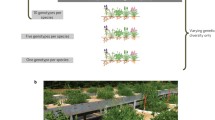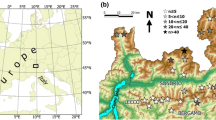Abstract
Species diversity influences the productivity and stability of plant communities, but its effect on the evolution of species within those communities is poorly understood. In this study, we tested whether species diversity and soil type influence selection on physiology in switchgrass (Panicum virgatum). Plants were grown in 0.33–0.55 ha plots in eight full-factorial treatment combinations: four diversity treatments (1 species—switchgrass monoculture; 5 species—a mix of C4 grasses; 16 species—a mix of grasses, forbs, and legumes; 32 species—a mix of grasses, forbs, legumes, and sedges) and two soil types (Waukee loam “loam” and Spillville–Coland alluvial complex “clay”). We measured selection on photosynthetic rate, chlorophyll concentration, and specific leaf area in each treatment combination and compared the strength of selection between soil types and diversity treatments. When significant, selection favored increased photosynthesis, increased chlorophyll concentration, and decreased specific leaf area in all treatment combinations. Selection for these attributes was stronger in the faster-draining loam soil than the slower-draining clay soil. Selection rarely differed significantly between diversity treatments; however, most instances in which selection differed significantly between soil types occurred in the high-diversity mixes suggesting that diversity alters the impact of soil type as an agent of selection. Selection may have been stronger in the loam soil because of its lower available water capacity. There was a lengthy summer drought during our experiment. Under these conditions, plants with high photosynthesis and chlorophyll concentration would have more resources to invest in their root system for water uptake. Increased capacity for water uptake would benefit plants in both soil types during drought but would have greater adaptive significance in the faster-draining loam soil. Our results suggest that species diversity is a weak agent of selection and only influences physiological evolution by modifying the pressures exerted by other environmental factors.



Similar content being viewed by others
References
Abdala-Roberts L, Marquis R (2007) Local adaptation based on biotic interactions and soil abiotic conditions in the ant-tended Chamaecrista fasciculata (Fabaceae). Oecologia 154:315–326
Ackerly DD, Dudley SA, Sultan SE et al (2000) The evolution of plant ecophysiological traits: recent advances and future directions. Bioscience 50:979–995
Agrawal AA, Erwin AC, Cook SC (2008) Natural selection and predicted response for ecophysiological traits of swamp milkweed (Asclepias incarnata) in the field. Ecology 96:536–542
Arntz M, Delph L (2001) Pattern and process: evidence for evolution of photosynthetic traits in natural populations. Oecologia 127:455–467
Arntz AM, DeLucia EH, Jordan N (1998) Contribution of photosynthetic rate to growth and reproduction in Amaranthus hybridus. Oecologia 117:323–330
Arntz M, DeLucia D, Jordan N (2000) From fluorescence to fitness: variation in photosynthetic rate affects fecundity and survivorship. Ecology 81:2567–2576
Balvanera P, Pfisterer AB, Buchmann N et al (2006) Quantifying the evidence for biodiversity effects on ecosystem functioning and services. Ecol Lett 9:1146–1156
Beaty E, Engel J, Powell J (1978) Tiller development and growth in switchgrass. J Range Manag 31:361–365
Bradshaw AD, Chadwick MJ, Jowett D et al (1964) Experimental investigations into the mineral nutrition of several grass species, IV. Nitrogen level. Ecology 52:665–676
Broadbent FE (1965) Organic matter. In: Black CA (ed) Methods of soil analysis. Agron. Monogr. 9. American Society of Agronomy, Madison, pp 1397–1400
Buswell JM, Moles AT, Hartley S (2011) Is rapid evolution common in introduced plant species? J Ecol 99:214–224
Callaway R (1995) Positive interactions among plants. Bot Rev 61:306–349
Cardinale BJ, Wright JP, Cadotte MW et al (2007) Impacts of plant diversity on biomass production increases through time because of species complementarity. Proc Natl Acad Sci 104:18123–18128
Caruso CM, Maherali H, Sherrard ME (2006) Plasticity of physiology in Lobelia: testing for adaptation and constraint. Evolution 60:980–990
Chapin FS III (1980) The mineral nutrition of wild plants. Annu Rev Ecol Syst 11:233–260
Conner JK (1988) Field measurements of natural and sexual selection in the fungus beetle, Bolitotherus cornutus. Evolution 42:736–749
Donovan LA, Dudley S, Rosenthal DM et al (2007) Phenotypic selection on leaf WUE and related ecophysiological traits for natural populations of desert sunflowers. Oecologia 52:13–25
Donovan LA, Ludwig F, Rosenthal DM et al (2009) Phenotypic selection on leaf ecophysiological traits in Helianthus. New Phytol 183:868–879
Donovan LA, Maherali H, Caruso CM et al (2011) The evolution of the worldwide leaf economics spectrum. Trends Ecol Evol 26:88–95
Dudley S (1996) Differing selection on plant physiological traits in response to environmental water availability: a test of adaptive hypotheses. Evolution 50:92–102
Fargione J, Tilman D, Dybzinski R et al (2007) From selection to complementarity: shifts in the causes of biodiversity–productivity relationships in a long-term biodiversity experiment. Proc R Soc 274:871–876
Farris MA, Lechowicz MJ (1990) Functional interactions among traits that determine reproductive success in a native annual plant. Ecology 71:548–557
Franks SJ (2011) Plasticity and evolution in drought avoidance and escape in the annual plant Brassica rapa. New Phytol 190:249–257
Garnier E, Shipley B, Roumet C et al (2001) A standardized protocol for the determination of specific leaf area and leaf dry matter content. Funct Ecol 15:688–695
Geber M, Griffen L (2003) Inheritance and natural selection on functional traits. Int J Plant Sci 164:521–542
Grime JP (2001) Plant strategies, vegetation processes, and ecosystem properties (2E). Wiley, Chichester
Grime JP, Hunt R (1975) Relative growth-rate: its range and adaptive significance in a local flora. Ecology 63:393–422
Heaton E, Voigt T, Long SP (2004) A quantitative review comparing the yields of two candidate C4 perennial biomass crops in relation to nitrogen, temperature and water. Biomass Bioenergy 27:21–30
Hector A, Shmid B, Beierkuhniein C et al (1999) Plant diversity and productivity experiments in European grasslands. Science 286:1123–1127
Hereford J, Hansen TF, Houle D (2004) Comparing strengths of directional selection: how strong is strong? Evolution 58:2133–2143
Heschel MS, Riginos C (2005) Mechanisms of selection for drought stress tolerance and avoidance in Impatiens capensis (Balsaminaceae). Am J Bot 92:37–44
Heschel MS, Donohue K, Hausmann N et al (2002) Population differentiation and natural selection for water-use efficiency in Impatiens capensis (Balsaminaceae). Int J Plant Sci 163:907–912
Heschel MS, Sultan S, Glover S et al (2004) Population and plastic responses to drought stress in the generalist annual Polygonum persicaria. Int J Plant Sci 165:817–824
Hooper DU, Chapin FS III, Ewel JJ et al (2005) Effects of biodiversity on ecosystem functioning: a consensus of current knowledge. Ecol Monogr 75:3–35
Hudson B (1994) Soil organic matter and available water capacity. J Soil Water Conserv 49:189–194
Huston MA (1997) Hidden treatments in ecological experiments: re-evaluating the ecosystem function of biodiversity. Oecologia 110:449–460
Isbell FI, Wilsey BJ (2011) Increasing native, but not exotic, biodiversity increases aboveground productivity in ungrazed and intensely grazed grasslands. Oecologia 165:771–781
Kingsolver JG, Hoekstra HE, Hoekstra JM et al (2001) The strength of phenotypic selection in natural populations. Am Nat 157:245–261
Kingsolver JG, Diamond SE, Siepielski AM et al (2012) Synthetic analyses of phenotypic selection in natural populations: lessons, limitations and future directions. Evol Ecol 26:1101–1118
Lambers H, Poorter H (1992) Inherent variation in growth rate between higher plants: a search for physiological causes and ecological consequences. Adv Ecol Res 23:187–261
Lande R, Arnold S (1983) The measurement of selection on correlated characters. Evolution 37:1210–1226
Levine J (2000) Species diversity and biological invasions: relating local process to community pattern. Science 288:852–854
Loreau M, Hector A (2001) Partitioning selection and complementarity in biodiversity experiments. Nature 412:72–76
Loreau M, Naeem S, Inchausti P et al (2001) Biodiversity and ecosystem functioning: current knowledge and future challenges. Science 294:804–808
Lovelock C, Felle I, McKee M et al (2004) The effect of nutrient enrichment on growth, photosynthesis and hydraulic conductance of dwarf mangroves in Panama. Funct Ecol 18:25–33
Ludwig F, Rosenthal DM, Johnston JA et al (2004) Selection on leaf ecophysiological traits in a desert hybrid Helianthus species and early generation hybrids. Evolution 58:2682–2692
Maron JL, Vilà M, Bommarco R et al (2004) Rapid evolution of an invasive plant. Ecol Monogr 74:261–280
Myers M, Hoksch B, Mason J (2012) Butterfly response to floral resources during early establishment at a heterogeneous prairie biomass production site in Iowa, USA. J Insect Conserv 16:457–472
Natural Resource Conservation Service (2009) Planting and managing switchgrass as a biomass energy crop. Technical Note No. 3. http://www.nrcs.usda.gov/Internet/FSE_DOCUMENTS/stelprdb1042293.pdf
Natural Resource Conservation Service (2014) Web soil survey. http://websoilsurvey.sc.egov.usda.gov/App/WebSoilSurvey.aspx (accessed August 2014)
Neter J, Wasserman W, Kutner MH (1989) Applied linear statistical models. Irwin, Homewood
Parachnowitsch A, Cook-Patton SC, McArt SH (2014) Neighbours matter: natural selection on plant size depends on the identity and diversity of the surrounding community. Evol Ecol 28:1139–1153
Poorter H, Remkes C (1990) Leaf area ratio and net assimilation rate of 24 wild species differing in relative growth rate. Oecologia 83:553–559
Rausher MD (1992) The measurement of selection on quantitative traits: biases due to environmental covariances between traits and fitness. Evolution 46:616–626
Reich PB, Ellsworth DS, Walters MB et al (1999) Generality of leaf trait relationships: a test across six biomes. Ecology 80:1955–1969
Sandquist D, Ehleringer J (2003) Population- and family-level variation of brittlebush (Encelia farinose, Asteraceae) pubescence: its relation to drought and implications for selection in variable environments. Am J Bot 90:1481–1486
Schmer M, Vogel K, Mitchell R et al (2008) Net energy of cellulosic ethanol from switchgrass. Proc Natl Acad Sci USA 105:464–496
Sherrard M, Maherali H (2006) The adaptive significance of drought escape in Avena barbata, an annual grass. Evolution 60:2478–2489
Sims D, Kelley S (1998) Somatic and genetic factors in sun and shade population differentiation in Plantago lanceolata and Anthoxanthum odoratum. New Phytol 140:75–84
Sokal RR, Rohlf FJ (1995) Biometry. Freeman, New York
Stinchcombe JR, Rutter MT, Burdick DS et al (2002) Testing for environmentally induced bias in phenotypic estimates of natural selection: theory and practice. Am Nat 160:511–523
Tilman D, Wedin D, Knops JMH (1996) Productivity and sustainability influenced by biodiversity in grassland ecosystems. Nature 379:718–720
Tilman D, Reich PB, Knops JMH et al (2001) Diversity and productivity in a long-term grassland experiment. Science 294:843–845
Tilman D, Reich PB, Knops JMH (2006) Biodiversity and ecosystem stability in a decade long grassland experiment. Nature 441:629–632
Tran TS, Simard RR (1993) Mehlich III-extractable elements. In: Carter M (ed) Soil sampling and methods of analysis. Lewis Publishers, Boca Raton, pp 43–49
Verhoeven KJF, Biere A, Nevo E et al (2004) Differential selection of growth rate-related traits in wild barley, Hordeum spontaneum, in contrasting greenhouse nutrient environments. J Evol Biol 17:184–196
Wade M, Kalisz S (1990) The causes of natural selection. Evolution 44:1947–1955
Whitney DA (1998) Micronutrients: zinc, iron, manganese and copper. In: Brown JR (ed) Recommended chemical soil test procedures for the North Central region, NCR Publication Number 221 (Revised). Missouri Agricultural Experimental Station, Columbia, pp 41–44
Wright IJ, Reich PB, Westoby M et al (2004) The worldwide leaf economics spectrum. Nature 428:821–827
Yachi S, Loreau M (1999) Biodiversity and ecosystem productivity in a fluctuating environment: the insurance hypothesis. Proc Natl Acad Sci 96:1463–1468
Acknowledgments
We thank Mark Myers, Dustin Graham, Dave Williams, and Jessica Abernathy for helpful discussions on the manuscript. We thank Angela Wrage, Kyle Dvorak, Layton Weishaar, Karen Lobmeyer, Daryl Smith, Jordan Koos, Zachary Kockler, Dave Williams, and the Tallgrass Prairie Center for assistance in the field and lab. We thank Jody Ohmacht and Gavin Simmons from the National Laboratory for Agriculture and the Environment (NLAE) for collecting the soil samples and the analytical laboratory at NLAE for conducting the soil analysis. This work was supported by Iowa EPSCoR under NSF Grant No. EPS-1101284, the Iowa Power Fund, and the University of Northern Iowa.
Author information
Authors and Affiliations
Corresponding author
Electronic supplementary material
Below is the link to the electronic supplementary material.
Rights and permissions
About this article
Cite this article
Sherrard, M.E., Joers, L.C., Carr, C.M. et al. Soil type and species diversity influence selection on physiology in Panicum virgatum . Evol Ecol 29, 679–702 (2015). https://doi.org/10.1007/s10682-015-9770-y
Received:
Accepted:
Published:
Issue Date:
DOI: https://doi.org/10.1007/s10682-015-9770-y




